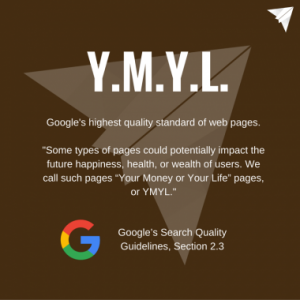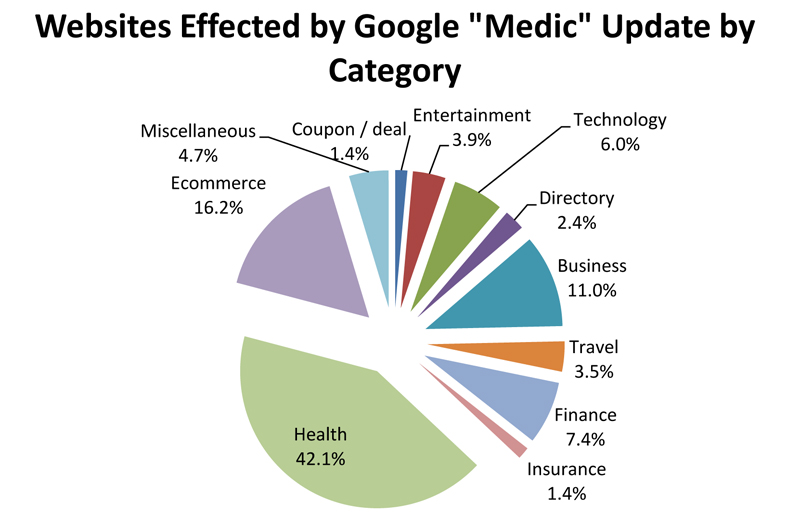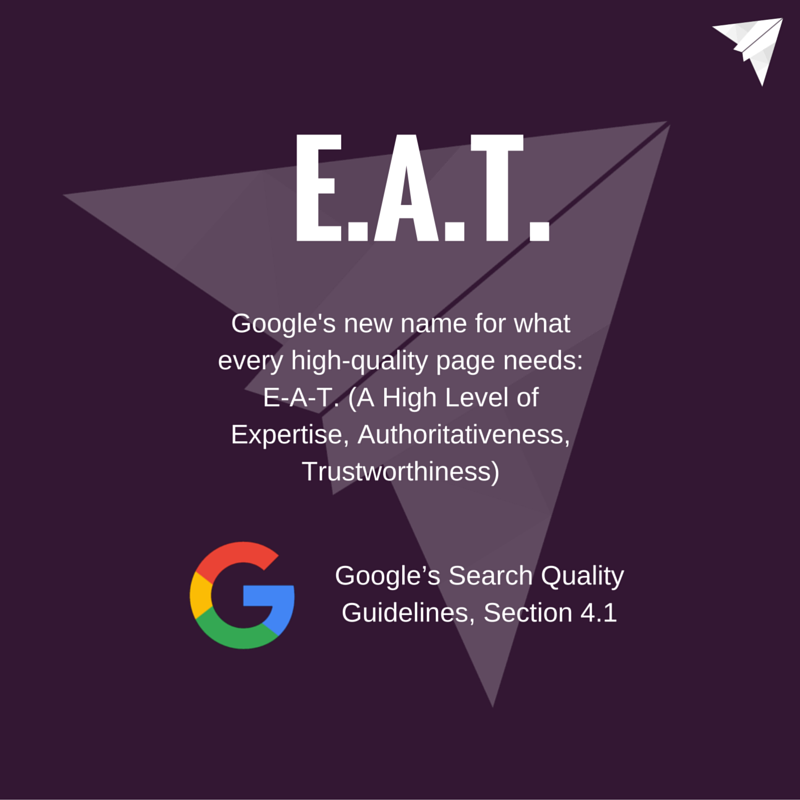Online, not all content is created equally. Google holds financial, legal, and medical information to a higher standard. In this post, learn how to create financial content Google will love.
Many people identify the “equality” as an American value. After all, the Constitution opens “We the People of the United States, in Order to form a more perfect union” – a pronouncement that implies a group of individuals coming together to speak with equal authority. The same cannot be said about be said about content on the Internet. Financial, legal, and medical information and advice is not the same as automotive, travel, and home repair advice. There can be serious consequences when we base our decisions on incorrect financial, legal, and legal advice. This is why we as a society require many professions to demonstrate a level of competency in the form of licensure before they can dispense advice professionally.
Realizing that not all information is created equal, Google holds financial, legal, and medical information to a higher standard. Specifically, they pay special attention to content about a person’s “health, wealth, and happiness”. If your website has such content, you need to be aware that Google is holding your website to a higher standard.
Digital marketing, like government loves acronyms. As a result, there is an acronym for the pages containing content about a person’s “health, wealth, and happiness”.
What are YMYL Pages?
Called YMYL pages, short for “Your money or your life”, they refer to much more than just money.
According to Google, any page including content that can affect a person’s health, happiness, safety or financial stability is a YMYL page.
If you are a financial advisor dispensing financial or investing advice, you have YMYL pages.
If your website gives out tax advice, you have YMYL pages.
If your website diagnoses ailments based on symptoms, you have YMYL pages
So, just what does Google say about YMYL pages? Let’s take a look:
- Shopping or financial transaction pages: web pages that allow users to make purchases, transfer money, pay bills and so forth online. Examples include online stores and online banking pages.
- Financial information pages: web pages that provide advice or information about investments, taxes, retirement planning, paying for college, buying a home or buying insurance, and so forth.
- Medical information pages: web pages that provide legal advice or information about health, drugs, specific diseases or conditions, nutrition, mental health, and so forth.
- New articles or public/information pages that are important for having an informed citizenry: web pages include information about local/state/national government processes, policies, people, and laws. Examples of such information include disaster response services, government and social service programs, news about important topics such as International events, business, politics, science and technology and so on.
- Other: there are many additional topics that can be considered YMYL content, such as car safety information, child adoption and so forth.
Looking at the type of content that constitutes YMYL, this is much of the same information that professional services providers deal with on a daily basis. This includes financial and wealth advisors, CPAs, Lawyers, Doctors, Dentists, and so on.
If you are a professional services provider that markets your services online, this information is very important.
Google’s “Medic” update
Google assigns names to major search algorithm updates. On August 1, 2018, Google released an update to their organic search algorithm that specifically focused on YMYL pages. Dubbed the “Medic” update, Google’s algorithm change affected primarily websites in the Health and Wellness industry. However, the “Medic” update also affected websites in the e-commerce, finance and business industries as well.
At its core, the Medic update is addressing a site’s trustworthiness and authority.
At this point, you probably just want to know how to get your YMYL page up to speed?
YMYL Pages Held To A Higher Standard
Google uses very high quality rating standards on YMYL pages because bad information could hurt people financially, physically, and emotionally.
Just how does Google determine the quality of a web page?
They use quality raters. This is a group that numbers 10,000 people around the world whose sole purpose is to evaluate search results. They basically validate search results produced by Google’s search algorithm to ensure that Google search engine users find the information that they are looking for online.
Search quality raters are given actual searches to perform and they then report back on the quality of results they get. They specifically rate the quality of pages at the top of search engine results. The higher the quality of the information sought, the more likely that it is that Google search results returned the kinds of results that people would expect to see.
When search quality raters come across a YMYL page, they will rate that page. When they do, they evaluate that page against a stricter set of standards than they would use for other pages because of the potential impact of the content.
If your website has a YMYL page, you will need to do more than just optimize it for the Google’s search algorithm. You will need to make sure that Google’s search quality raters really like your content.
Expertise, Authority, and Trust
It is time to learn another acronym, E-A-T. E-A-T refers to expertise, authority, trustworthiness and is in fact three rules pertaining to your content. Specifically:
- Expertise – is the author of the content an expert on the subject?
- Authority – is the author of the content a well-recognized authority on the subject?
- Trustworthiness – is the content accurate?
If you are trying to optimize an authority site and you don’t pay attention to of the rules, Google’s quality raters may give your page a “low quality” rating. If that happens, your site will not make it to the top of the search engine results pages (SERPs).
Let’s take a look at how Google ensures your site follows the E-A-T rules.
How To Establish Yourself As An Expert
The best way to establish yourself as an expert in your field is to publish content. Position yourself as a subject matter expert (SME, another acronym) by creating lots of content that in and of itself, shows you are knowledgeable in your space. Additionally, you should brag about yourself on your home page.
How do you convey expertise?
Do you have professional certificates? Share them online. Use logos of standards organizations, if possible.
Do you have an advanced or professional degree? Be sure to include that on your website as well.
If you have a Ph.D, M.D. or J.D next to your name, use it. This makes you “Dave Jones, Ph.D, M.D., or J.D.”.
Can you be an expert but not an authority? Absolutely.
How to establish yourself as an authority
You could know everything that there is to know about ETFs, trusts, or retirement plans but if you don’t have a blog, have never spoken at a conference, or have never been hired for your expertise, you are an expert but not an authority.
Experts have the brains. Authorities have the influence.
If you want your content to rank highly in SERPs, you need to establish yourself as an expert and then, you need to establish yourself as an authority. The latter may take a little bit more work.
To start, put social proof on your home page. Include quotations of people who praise the work you have done. If you have pictures or logos, even better.
Have you spoken at industry-relevant conferences? Does it matter if you weren’t paid to speak? No. With that said, look for opportunities to land speaking engagements.
When you are first starting out, don’t expect to get paid for your initial speaking gigs. Hopefully, that will come later.
If you land a gig as a keynote speaker, you have won the lottery in terms of E-A-T. Make sure you identify yourself as a “keynote speaker” on your blog.
Finally, gain the endorsement of key influencers. When popular people recommend your work , then people will perceive that you are an authority figure.
The next thing is very simple but constantly overlooked. Don’t include factual mistakes in your content.
When you include incorrect information in your blog posts, people will be turned off. Some of these people could be Google’s quality raters.
You should also allow people to review your work and content. Finally, include case studies if they are relevant. In your case studies, explain how the advice you gave made their lives better.
When using case studies, be sure to use real names of persons or businesses you have helped so people can confirm for themselves.
How to create a website that establishes you as an authority
There are some things you can do to help your website establish authority.
- Build a quality site. First appearances are everything. This applies not only to your website as well. A poorly designed website conveys that you shouldn’t be taken seriously. Make sure that your website does not have any bugs or 404 errors and that it also looks great on mobile devices.
- Establish the purpose of the page. Generally speaking, it is best to cover a single theme per article. There are of course exceptions to the rule. If you try to write about too many subjects at once, you are likely to confuse your reader.
- Provide thorough and detailed content. Long form content will more likely establish you as an expert than an article that is just 500 words long. Research your subject thoroughly and freely share what you have learned.
- Link to other expert pages. When you link to peer-reviewed articles and content created by other experts, you are showing that you have done your homework. Google search quality raters will notice this as well.
- Provide actionable advice. Share your knowledge by telling people how to apply the information you are sharing to make their lives better.
- Include an author bio. At the end of your content, add a biography with proof of your expertise in the subject. Be sure to include a professional picture as well.
- Make your address and phone number visible everywhere. Keep your address and phone number up front and easy to find.
To further help you with your website, here is a checklist you can use right now.
- How often is your website maintained and updated? Update out-of-date articles to make them current or won’t rank anymore. Additionally, routinely see what your site looks like on other platforms.
- Is your contact information easy to find? Are your readers able to figure out how to reach you quickly?
- Who is responsible for the content on your site?
- Is your content reputable and authoritative?
Wrapping it all up
When it comes to your YMYL pages, you are what you E-A-T.
The YMYL pages making up your website are under increased scrutiny. If your website offers this type of content, make sure you follow these rules to increase the likelihood of being found at of SERPs.
Hopefully, I was successful in showing you how to create financial content Google will love.







EjlIRrLmU
mSPsBUaZEcOJFzVv
gHWeAISqYfsyGBb
nzFaPJeGxwOtEuVN
xfKwYspoutRaFcv
RyjOYpXLSgIetrc
mcrGRvZxUM
KqogrZke
Pingback:B2C Content Marketing: How to Engage and Convert Consumers with Your Blog | Auto Writing Script
Pingback:B2C Content Marketing: How to Engage and Convert Consumers with Your Blog – ivoryarch-elephantcastle
Pingback:B2C Content Marketing: How to Engage and Convert Consumers with Your Blog - IM News
Pingback:B2C Content Marketing: How to Engage and Convert Consumers with Your Blog – nomadendigital
Pingback:B2C Content Marketing: How to Engage and Convert Consumers with Your Blog – chasepost
Pingback:B2C Content Marketing: How to Engage and Convert Consumers with Your Blog – glittertextlive
Pingback:B2C Content Marketing: How to Engage and Convert Consumers with Your Blog - Seoim News
Pingback:B2C Content Marketing: How to Engage and Convert Consumers with Your Blog - Pterodacty
Pingback:B2C Content Marketing: How to Engage and Convert Consumers with Your Blog – Scoop.it Blog – freezpost.com
Pingback:B2C Content Marketing: How to Engage and Convert Consumers with Your Blog - Scoop.it Blog - Digital Marketing Digest
Pingback:B2C Content Marketing: How to Engage and Convert Consumers with Your Blog – BloggingNews Hubb
Pingback:B2C Content Marketing: How to Engage and Convert Consumers with Your Blog – wolfgangherfurtner
Pingback:B2C Content Marketing: How to Engage and Convert Consumers with Your Blog – Help Business
Pingback:B2C Content Marketing: How to Engage and Convert Consumers with Your Blog – Ins Business
Pingback:B2C Content Marketing: How to Engage and Convert Consumers with Your Blog - Scoop.it Blog
Pingback:B2C Content Marketing: How to Engage and Convert Consumers with Your Blog - Cars Kitchen
Pingback:B2C Content Marketing: How to Engage and Convert Consumers with Your Blog – sdatbusiness
Pingback:B2C Content Marketing: How to Engage and Convert Consumers with Your Blog – Rating Business
Pingback:B2C Content Marketing: How to Engage and Convert Consumers with Your Blog – businessgrants
Pingback:B2C Content Marketing: How to Engage and Convert Consumers with Your Blog – Business Store
Pingback:B2C Content Marketing: How to Engage and Convert Consumers with Your Blog – The archers pub
Pingback:B2C Content Marketing: How to Engage and Convert Consumers with Your Blog – Silicon Business
Pingback:B2C Content Marketing: How to Engage and Convert Consumers with Your Blog – Large Business
IuyDgwelVmkM
Pingback:B2C Content Marketing: How to Engage and Convert Consumers with Your Blog – Mass Blog
NvhoLDEsjUCazf
Pingback:B2C Content Marketing: How to Engage and Convert Consumers with Your Blog | Keen Funnel
tXRTAdqc
dozqCTKDvcxEj
GLsqPmAMQWtSh